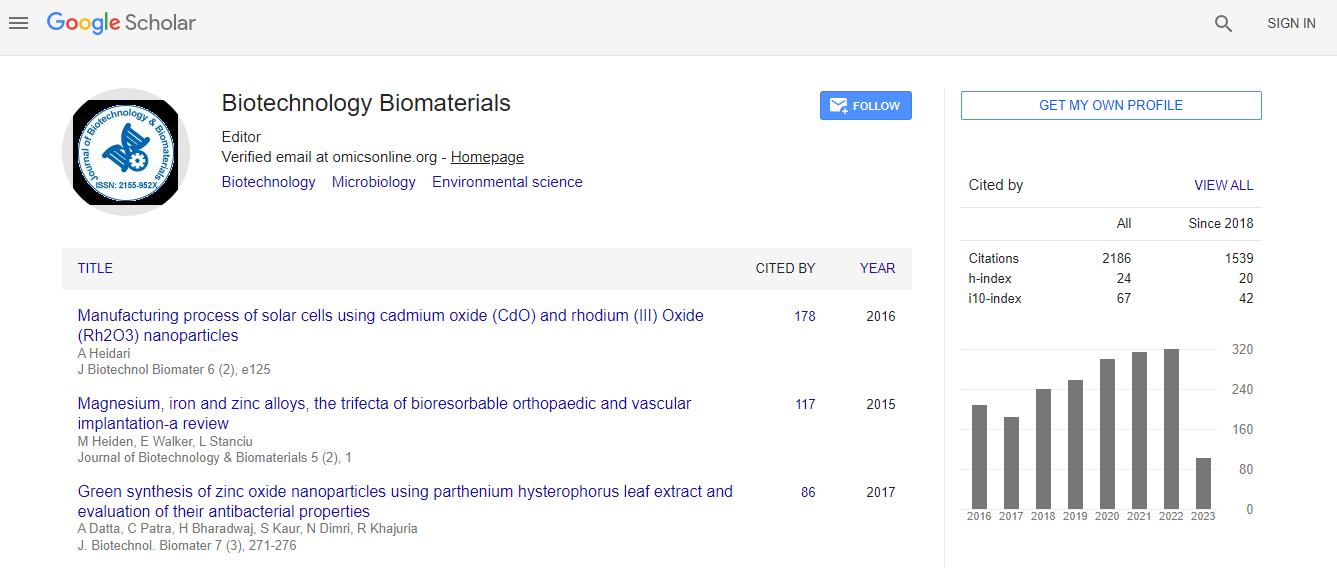Our Group organises 3000+ Global Conferenceseries Events every year across USA, Europe & Asia with support from 1000 more scientific Societies and Publishes 700+ Open Access Journals which contains over 50000 eminent personalities, reputed scientists as editorial board members.
Open Access Journals gaining more Readers and Citations
700 Journals and 15,000,000 Readers Each Journal is getting 25,000+ Readers
Google Scholar citation report
Citations : 3330
Journal of Biotechnology & Biomaterials received 3330 citations as per Google Scholar report
Indexed In
- Index Copernicus
- Google Scholar
- Sherpa Romeo
- Open J Gate
- Genamics JournalSeek
- Academic Keys
- ResearchBible
- China National Knowledge Infrastructure (CNKI)
- Access to Global Online Research in Agriculture (AGORA)
- Electronic Journals Library
- RefSeek
- Hamdard University
- EBSCO A-Z
- OCLC- WorldCat
- SWB online catalog
- Virtual Library of Biology (vifabio)
- Publons
- Geneva Foundation for Medical Education and Research
- Euro Pub
- ICMJE
Useful Links
Recommended Journals
Related Subjects
Share This Page
Optimization of cultural conditions and synergistic effect of corn cobs on cellulase production by Bacillus cereus LAZ518 isolated from cow dung
Industrial Biotechnology Congress
Magdy A AbuGharbia, Nagwa M El-Sawi, A A Nasr and Lyla A Zedan
Sohag University, Egypt
Posters-Accepted Abstracts: J Biotechnol Biomater
Abstract
Cellulases are the enzymes hydrolyzing cellulosic biomass and are produced by the microorganisms that grown over cellulosic matters. Bacterial cellulases possess more advantages when compared to the cellulases from other sources. Cellulase producing bacteria was isolated from Cow dung. The organism was identified using 16 SrRNA sequencing and BLAST search. One hundred different strains of Bacteria were isolated from cow dunk in Sohag governorate. Isolates were tested for their ability to produce extracellular Cellulases and hemicellulases. Of all these isolates Bacillus sp. that had the highest potential for Celluolytic and hemicelluolytic activity was chosen. From various morphological and physiological and properties, this isolate was found to belong to Bacillus sp. Physiological studies were conducted to determine the optimum cultural conditions for maximal cellulases and hemicellulases formation by B. cereus LAZ 518. Shaking condition at 150 rpm is favorable for the production of cellulases and hemicellulases from corn cobs. The highest enzyme yield was obtained at the second day of incubation (after 48 hours) at 50 �°C. however cellulases and hemicellulases formation occurred at a broad range of pH values, with maximal formation of B. cereus LAZ 518 cellulases and hemicellulases at pH 7.0 when corn cobs was used as sole carbon source, respectively Carboxymethyl cellulose (CMC) was found to be a good inducer for cellulases and hemicellulases formation with CMC concentrations of 1.0% (w/v) in case of corn cobs. High level of enzyme formation was obtained with the addition of yeast extract as a nitrogen source and at a concentration of 0.1% (v/v) Tween-80 as an addition to medium containing corn cobs increases enzymes production.Biography
Email:
abu.gharbia@yahoo.com
 Spanish
Spanish  Chinese
Chinese  Russian
Russian  German
German  French
French  Japanese
Japanese  Portuguese
Portuguese  Hindi
Hindi 
